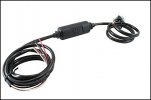Rajagra
Well-Known Member
- Joined
- Aug 15, 2015
- Messages
- 2,957
- Reaction score
- 2,356
- Country
- United Kingdom
- Dash Cam
- Mini0806
If you do it on the 12v supply then the voltage drop over time is not a problem because the voltage regulator in the adaptor will continue to output 5v until the capacitor is nearly empty. Your problem then is that you can't use a cheap supercap since it needs 6 in series to cope with the 14.6v car voltage (maximum with alternator running).
But at higher voltage you need fewer Farads to store the same amount of energy, so you can use lower capacity capacitors, reducing the cost somewhat.
Add in the benefit that a good regulator will maintain 5V output even when the capacitors total has dropped far below 12V, and this could be a better solution. You will get a flat 5V output for a good time, and more of the stored energy will be usable. Might be bulkier though.
Sent from my SM-G903F using Tapatalk

